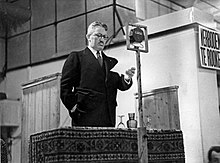Abraham Asscher
Abraham Asscher (born September 19, 1880 in Amsterdam ; † May 2, 1950 ) was a Dutch diamond dealer, Zionist , politician and member of the Chamber of Commerce in Amsterdam and chairman of the Joodse Raad in Amsterdam during the Second World War .
Life
Abraham Asscher was the owner and director of the world-famous diamond trading company and grinding company Asscher in Amsterdam, where his brother Joseph also cut the largest known diamond, Cullinan , in 1908 . He was also a member of the Chamber of Commerce in Amsterdam. In the northern Netherlands he represented the Liberal Party in the regional council between 1917 and 1940. As a Jewish functionary and Zionist, among other things, from 1932 he was chairman of the standing committee of the Ashkenazi congregations and also took over the presidency of the council of the Amsterdam Jewish congregation. Together with David Cohen he was one of the co-founders of the Committee for Special Jewish Matters ( Comité voor Bijzondere Joodsche Belangen, CBJB ) and was its head until the dissolution of this institution in March 1941. Between 1933 and 1939, the committee managed to remove 33,000 Jewish refugees from the To include the German Empire, part of which came from Eastern Europe and was stateless. 11,000 of them were helped on their onward journey.
After the German Reich had occupied the Netherlands, Hermann Göring bought diamonds from the Asscher diamond trade for 1.4 million guilders in May 1940 . From February 12, 1941, Asscher and Cohen led the forced union Joodse Raad initiated by the German occupiers, first for Amsterdam and later for the whole of the Netherlands. After the Jewish population was gradually excluded from public life, the Judenrat was also occupied with educational, welfare and elementary issues such as the procurement of clothing and food. The Dutch Jewish Council tried to save as many Jewish compatriots as possible from deportation and thus the Holocaust by exempting them , but this did not succeed. Asscher, like other members of the Joods Raads, was one of the last Jews remaining in the Netherlands to be deported to the Bergen-Belsen concentration camp via the Westerbork transit camp on September 23, 1943, together with other Jewish diamond dealers .
Because of his collaboration with the German occupiers, he was arrested after his return to the Netherlands and an investigation was initiated against him. After this case was discontinued, a trial before a Jewish community court followed in 1947, which found him guilty of collaboration. Asscher, who justified his actions during the occupation in the process, was banned from exercising functions in Jewish offices. Asscher, who withdrew completely from Jewish community life, did not recognize this judgment. As a result, Abraham Asscher is not buried in a Jewish cemetery.
literature
- Israel Gutman (Ed.): Encyclopedia of the Holocaust - The persecution and murder of European Jews , Piper Verlag, Munich / Zurich 1998, 3 volumes, ISBN 3-492-22700-7
- Saul Friedländer , Martin Pfeiffer : The Third Reich and the Jews , CH Beck, 2006, ISBN 9783406549663
Individual evidence
- ^ A b Israel Gutman (ed.): Encyclopedia of the Holocaust - The persecution and murder of European Jews , Munich / Zurich 1998, 1st volume, p. 90f.
- ^ Pim Griffioen: Westerbork. In: Dan Diner (Ed.): Encyclopedia of Jewish History and Culture (EJGK). Volume 6: Ta-Z. Metzler, Stuttgart / Weimar 2015, ISBN 978-3-476-02506-7 , p. 379f.
- ^ Friso Wielenga : The Netherlands: Politics and political culture in the 20th century. Waxmann, Münster 2008, ISBN 978-3-8309-1844-8 , p. 213
| personal data | |
|---|---|
| SURNAME | Asscher, Abraham |
| BRIEF DESCRIPTION | Dutch diamond dealer, politician, Zionist and Holocaust survivor |
| DATE OF BIRTH | September 19, 1880 |
| PLACE OF BIRTH | Amsterdam |
| DATE OF DEATH | May 2, 1950 |
